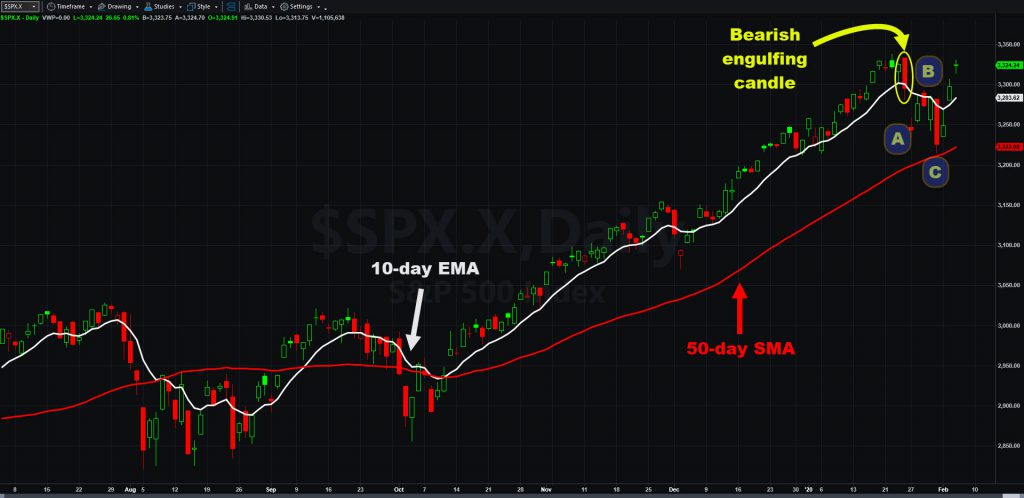Stocks have had an impressive run since breaking out in late October. Gains have been smooth and volatility has been low — despite negatives like geopolitical risk and coronavirus.
What if you missed the boat four months ago and needed an entry? The last two weeks had a example of a classic “buy the pullback” setup, known as an ABC Correction. Here’s how it worked.
Chasing the Market Is Risky
It seldom pays to chase the market at highs, when it’s extended in price. Patiently waiting for a pullback into an area of support is many times a safer course of action.
Investors got indications a pullback might occur back on Friday, January 24. First, the S&P 500 had a large bearish engulfing candle: It opened at a higher high, but then fell to close beneath the previous session’s low. That’s a common sign of exhaustion.
Second, the index ended below its 10-day exponential moving average (EMA), which had provided support for most of the rally. Both of these things happened on heavy volume — another sign of bears stepping in.
Stocks kept dropping the next Monday, January 27. The S&P 500 gapped down 1.6 percent. It quickly rebounded and tagged the 10-day EMA from the downside. That old support became resistance, hammering the index down another 1.8 percent.
By the time it was all said and done, the S&P 500 was 3.7 percent below its old high. It also formed an ABC correction along the way.

What’s an ABC Correction?
The ABC correction is basically a zigzag lower.
- Part A: A chart is moving higher and then drops.
- Part B: It rebounds but makes a lower high.
- Part C: Prices continue down to make a lower low. Sometimes they might hold the first low. That’s also known as a retest or a double-bottom.
A word of caution! Be careful because many stocks could make lower highs and lower lows! It’s usually bearish! That’s why we need to see other patterns before we identify a decline as an ABC correction.
The first requirement is that the stock must be in a bigger uptrend. The drop has to go against the primary bullish trend. We also want to see another area of support, like the 50-day simple moving average (SMA).
Making the Most of Pullbacks
The ABC Correction can help traders looking to buy pullbacks instead of chasing breakouts. Following its sequence can also avoid jumping in and out at the wrong places.
After all, lots of traders buy the initial drop. They’re happy when it bounces, but then get stopped out as prices roll over and slam down again. Leg C shakes out the weak holders.
It also lays the groundwork for a bounce because those same sellers often return as buyers as the market rebounds.
Finally, don’t forget about the secondary level. In this case it was the 50-day SMA, but it can also be something else like a trend line or previous peak. We always want more patterns helping to confirm our decisions.
In conclusion, the market’s recent pullback was a classic example of the ABC Correction. You might have missed it. But you can learn from this example and be ready the next time.
























